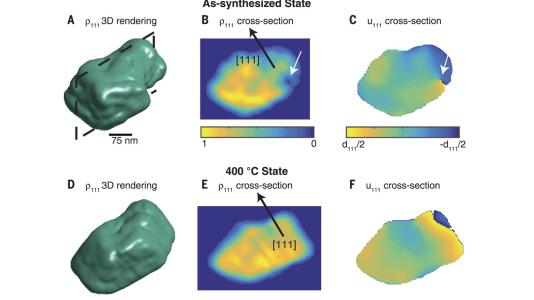
Scientific Achievement
Bragg coherent diffraction imaging (BCDI) reveals internal strain, defect annihilation, and growth of single grains in a polycrystalline Au film during annealing.
Significance and Impact
This work shows that BCDI can be broadly used to understand the links between grains, their defects, and the properties of polycrystalline materials.
Research Details
- BCDI was performed during annealing of a polycrystalline Au film to observe the evolution of the shape of individual grains and their internal strain fields with 10-nanometer spatial and subangstrom displacement field resolution
- Dislocation loops terminating at grain boundaries were identified, and their evolution followed as the sample was heated in steps
- We observed a dislocation loop annihilating into a grain boundary at 400 C, locally enhancing grain growth
- Dynamics of coherent twin boundaries were also observed
- Extension of BCDI imaging from nanoparticles to polycrystalline films opens a new window on an important class of materials
Argonne National Laboratory seeks solutions to pressing national problems in science and technology. The nation’s first national laboratory, Argonne conducts leading-edge basic and applied scientific research in virtually every scientific discipline. Argonne researchers work closely with researchers from hundreds of companies, universities, and federal, state and municipal agencies to help them solve their specific problems, advance America’s scientific leadership and prepare the nation for a better future. With employees from more than 60 nations, Argonne is managed by UChicago Argonne, LLC for the U.S. Department of Energy’s Office of Science.
The U.S. Department of Energy’s Office of Science is the single largest supporter of basic research in the physical sciences in the United States and is working to address some of the most pressing challenges of our time. For more information, visit https://energy.gov/science.